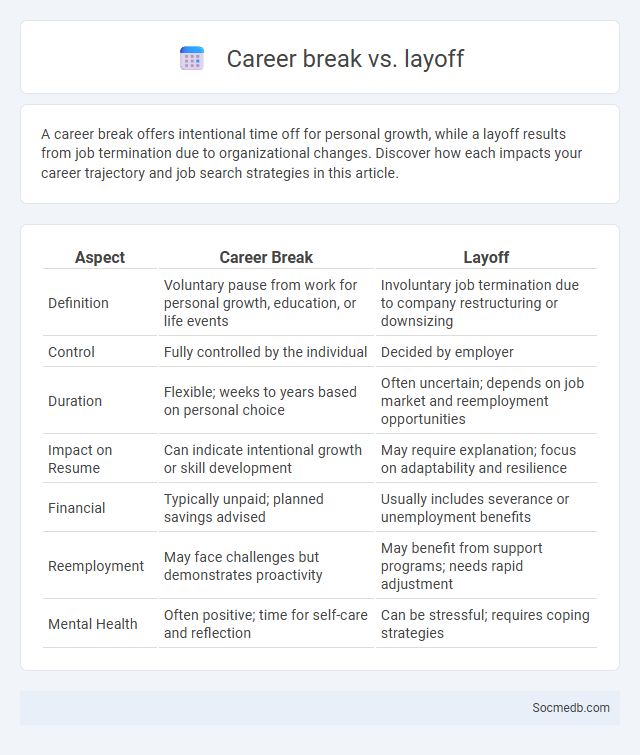
Photo illustration: Career break vs Layoff
A career break offers intentional time off for personal growth, while a layoff results from job termination due to organizational changes. Discover how each impacts your career trajectory and job search strategies in this article.
Table of Comparison
| Aspect | Career Break | Layoff |
|---|---|---|
| Definition | Voluntary pause from work for personal growth, education, or life events | Involuntary job termination due to company restructuring or downsizing |
| Control | Fully controlled by the individual | Decided by employer |
| Duration | Flexible; weeks to years based on personal choice | Often uncertain; depends on job market and reemployment opportunities |
| Impact on Resume | Can indicate intentional growth or skill development | May require explanation; focus on adaptability and resilience |
| Financial | Typically unpaid; planned savings advised | Usually includes severance or unemployment benefits |
| Reemployment | May face challenges but demonstrates proactivity | May benefit from support programs; needs rapid adjustment |
| Mental Health | Often positive; time for self-care and reflection | Can be stressful; requires coping strategies |
Understanding Career Breaks
Understanding career breaks involves recognizing their impact on skill development, networking opportunities, and personal growth. Social media platforms offer valuable tools for You to showcase your experiences, stay connected with industry professionals, and enhance your visibility during transitions. Leveraging LinkedIn and other career-focused networks can effectively communicate the value of your break and support a smooth reentry into the workforce.
Defining a Layoff
A layoff refers to the temporary or permanent termination of employment initiated by an employer, often due to economic downturns or company restructuring. In social media contexts, layoffs can drastically affect brand reputation and employee morale, leading to public scrutiny and negative sentiment. Your understanding of the factors driving layoffs helps in managing communication strategies and maintaining transparency with your audience.
Key Differences Between Career Breaks and Layoffs
Career breaks typically involve planned time off that You initiate for personal growth, education, or travel, while layoffs are employer-driven terminations due to organizational restructuring or economic downturns. Layoffs often result in immediate job loss and financial uncertainty, whereas career breaks can provide intentional breaks without job insecurity. Understanding these key differences helps You strategically manage your professional profile on social media and communicate your career status effectively.
Common Reasons for Taking a Career Break
Career breaks often stem from common reasons such as pursuing further education, managing personal health, or addressing family responsibilities. You may also consider a hiatus to reassess career goals or gain new skills through travel or volunteering. Social media platforms provide valuable support and insights for professionals planning and navigating these transitions effectively.
Layoff Causes and Implications
Social media layoffs often stem from shifting advertising revenues, increased operational costs, and evolving user engagement trends impacting platform profitability. Your ability to adapt to these changes is crucial as downsizing can lead to reduced innovation, diminished user experience, and potential data privacy concerns. Understanding these causes and implications helps you navigate the social media landscape more effectively.
Voluntary Career Break: Pros and Cons
Taking a voluntary career break can enhance personal growth and skill development by allowing individuals to pursue further education, travel, or focus on mental health. However, gaps in employment history may pose challenges when re-entering the job market, potentially impacting salary negotiations and career progression. Balancing the benefits of rejuvenation with the risks of professional stagnation is essential for maximizing the advantages of a voluntary career break.
Involuntary Layoff: Short-term and Long-term Effects
Involuntary layoffs significantly impact employees' mental health by increasing stress and anxiety levels, which can reduce productivity and social engagement on platforms like LinkedIn and Twitter. Short-term effects include immediate job insecurity and financial strain, leading to increased social media activity as individuals seek networking opportunities and support groups. Long-term consequences often involve diminished professional reputation and career progression challenges, making strategic social media use essential for rebuilding personal brand and accessing new employment opportunities.
How to Explain Career Breaks and Layoffs to Employers
When explaining career breaks or layoffs to employers, focus on honesty and highlight the skills gained or maintained during the period, such as freelance work, courses, or volunteering. Emphasize your readiness to return to full-time employment and how the break allowed for personal or professional growth. Use clear examples to demonstrate resilience, adaptability, and a proactive approach to overcoming challenges.
Strategies for Returning to Work After a Career Break or Layoff
Leveraging social media platforms like LinkedIn and Twitter enhances visibility when returning to work after a career break or layoff by showcasing updated skills and professional achievements. Engaging in industry-specific groups and sharing relevant content positions candidates as knowledgeable and motivated, attracting potential employers and recruiters. Consistent networking and personalized messaging on social media facilitate meaningful connections, increasing opportunities for job interviews and referrals.
Career Break vs Layoff: Which Is Right for You?
Career breaks offer you a planned pause to gain new skills or recharge, often enhancing your long-term job prospects, while layoffs are involuntary job losses that require immediate job search and financial adjustment. Social media platforms can be powerful tools to network, showcase your expertise, and find opportunities whether you're navigating a career break or recovering from a layoff. Understanding the differences helps you leverage these platforms strategically to maintain your professional presence and secure your next role.
 socmedb.com
socmedb.com